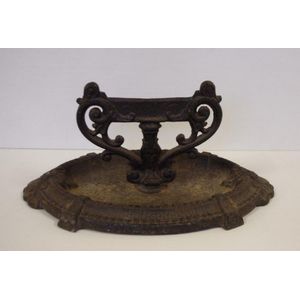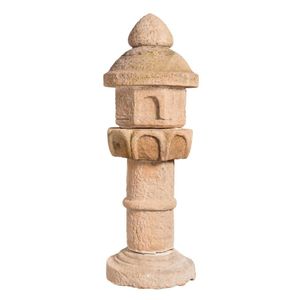Hornbill Sepik Figure on Four-Legged Base
You must be a subscriber, and be logged in to view price and dealer details.
Subscribe Now to view actual auction price for this item
When you subscribe, you have the option of setting the currency in which to display prices to $Au, $US, $NZ or Stg.
- Patination / Patina - In broad terms, patination refers to the exterior surface appearance of the timber, the effect of fading caused by exposure to sunlight and air over the course of a century or more, changing the piece to a soft, mellow colour.
As patina is very difficult to replicate, it is one of the most important guides to determining the age of furniture.
Patina is also the term applied to the bloom or film found on old bronzes due to oxidisation. - Hornbill - Oriental antique descriptions occasionally refer to "hornbill" or "hornbill ivory" as the material from which the object is made. In fact the hornbill is a large bird, the helmeted hornbill, found in a few South-East Asian countries, and the name is also applied to the material obtained from a growth on the upper section of the beak of the bird, known as a casque.
In its natural form it is a yellow colour, but when the hornbill rubs its beak while preening its feathers, the growth turns a red colour.
As well as being used as a carving material in areas where the bird is found, hornbill became popular as a carving medium with the Chinese in the 19th century, and it was prized (and priced) ahead of ivory and jade.
The helmeted hornbill is listed in Appendix 1 of CITES, (Convention on International Trade in Endangered Species) meaning that trade in hornbill objects requires import and export permits.
the s natural ivory from the bird, native to Indonesia. The hornbill is now an endangered species, but due to the apparent age of the jewelry, this item would be legal for trade. Hornbill ivory is not a true ivory as it is not a dentine material, but rather a keratin. Hornbill ivory of this nature was often carved from the lower layer of the hornbill casque for the western market. The upper area, with a strong red coloration, was traded to the Eastern market. The upper areas of these pieces yet show some of the red coloring. The rest is in the strong yellowish color of natural hornbill.
This item has been included into following indexes:
Visually similar items

FRANZ BERGMAN, Austrian (1861-1936), Cold painted bronze of an exotic dancer, signed NAM GREB, 20th century, 19 cm high

Cast iron boot scraper, 40 cm long

A Kamanggabi cult hook, Arambak Tribe, Karawari river, This large and impressive cult figure known as Yipwon are from the lower Karawari river area, carved from a single large piece of timber, the whole figure is seen in profile, the large head at the top

Two Japanese stone lanterns, 17th/18th century
